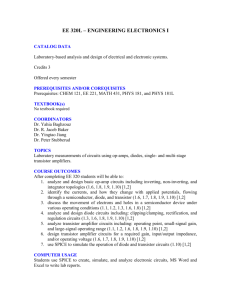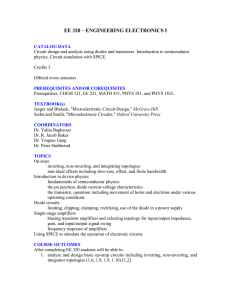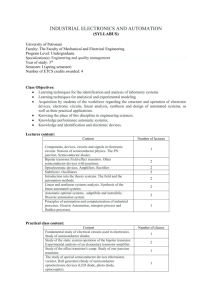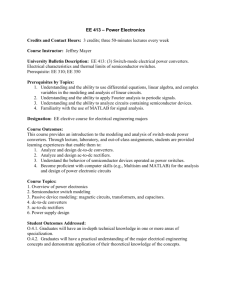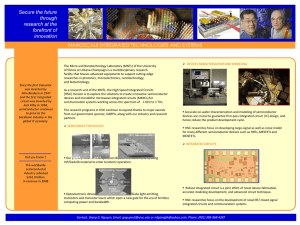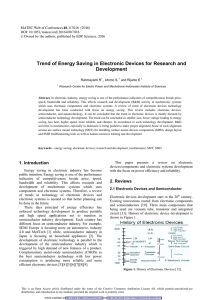Chabot College Fall 2004 Course Outline for Electronics and Computer Technology 62A
advertisement
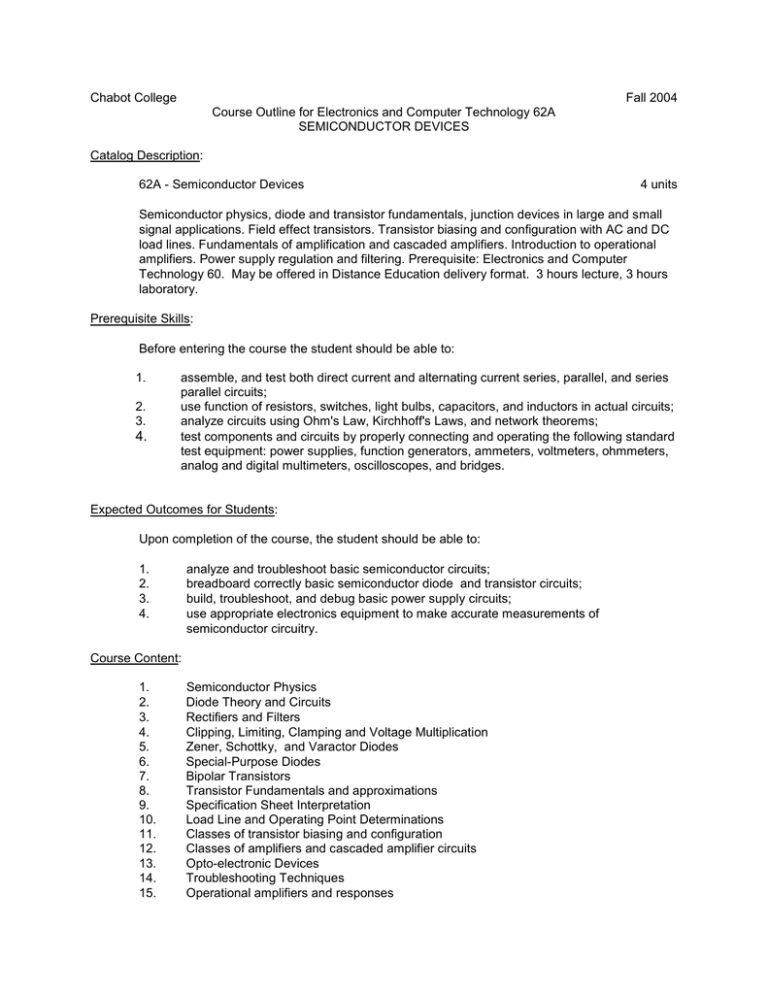
Chabot College Fall 2004 Course Outline for Electronics and Computer Technology 62A SEMICONDUCTOR DEVICES Catalog Description: 62A - Semiconductor Devices 4 units Semiconductor physics, diode and transistor fundamentals, junction devices in large and small signal applications. Field effect transistors. Transistor biasing and configuration with AC and DC load lines. Fundamentals of amplification and cascaded amplifiers. Introduction to operational amplifiers. Power supply regulation and filtering. Prerequisite: Electronics and Computer Technology 60. May be offered in Distance Education delivery format. 3 hours lecture, 3 hours laboratory. Prerequisite Skills: Before entering the course the student should be able to: 1. 2. 3. 4. assemble, and test both direct current and alternating current series, parallel, and series parallel circuits; use function of resistors, switches, light bulbs, capacitors, and inductors in actual circuits; analyze circuits using Ohm's Law, Kirchhoff's Laws, and network theorems; test components and circuits by properly connecting and operating the following standard test equipment: power supplies, function generators, ammeters, voltmeters, ohmmeters, analog and digital multimeters, oscilloscopes, and bridges. Expected Outcomes for Students: Upon completion of the course, the student should be able to: 1. 2. 3. 4. analyze and troubleshoot basic semiconductor circuits; breadboard correctly basic semiconductor diode and transistor circuits; build, troubleshoot, and debug basic power supply circuits; use appropriate electronics equipment to make accurate measurements of semiconductor circuitry. Course Content: 1. 2. 3. 4. 5. 6. 7. 8. 9. 10. 11. 12. 13. 14. 15. Semiconductor Physics Diode Theory and Circuits Rectifiers and Filters Clipping, Limiting, Clamping and Voltage Multiplication Zener, Schottky, and Varactor Diodes Special-Purpose Diodes Bipolar Transistors Transistor Fundamentals and approximations Specification Sheet Interpretation Load Line and Operating Point Determinations Classes of transistor biasing and configuration Classes of amplifiers and cascaded amplifier circuits Opto-electronic Devices Troubleshooting Techniques Operational amplifiers and responses Chabot College Course Outline for Electronics and Computer Technology 62A, Page 2 Fall 2004 Methods of Presentation: 1. 2. 3. 4. Lectures and demonstrations Classroom discussion and problem solving Laboratory experiments Web based delivery modules Assignments and Methods of Evaluating Student Progress: 1. Typical Assignments a. Determine the Q-point for a specified transistor circuit b. Produce a graph detailing the frequency response of small-signal amplifier. c. Troubleshoot a CE amplifier using laboratory test equipment 2. Methods of Evaluating Student Progress a. Class participation b. Observation and critique of laboratory experiments c. Homework, and laboratory written reports d. Quizzes, Midterm and Final examinations Textbook(s) (Typical): Fundamentals of Analog Circuits, Floyd and Buchla; Prentice Hall, 2003 Special Student Materials: Electronic Breadboard with semiconductor component package. jc 10/28/03 ET62A course outline 1003.doc
